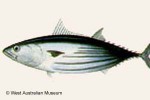Cook Islands Biodiversity Database
Species Page
Katsuwonus pelamis
‘Au‘opuSkipjack Tuna
Multimedia & Additional Resources
| Type | Description | Download |
| Adult | 11KB | |
| Illustration (B&W) including detail - pelvic fin | 82KB |
General Information
Cook Islands Distribution
| Southern Group: Present Makatea: | ||||||||
RR |
MG |
AT |
MK |
MT |
AK |
PL |
TK |
MN |
P |
^P |
^P |
P |
|||||
| Northern Group: Present | |||||
TN |
MH |
RK |
PK |
NS |
SW |
P |
P |
||||
Scientific Taxonomy
Katsuwonus pelamis (Linnaeus, 1758)
SYNONYMS: Euthynnus pelamis; Gymnosarda pelamis; Scomber pelamis [O]; Thinnus pelamis; Thynnus pelamis
TAXONOMY: ANIMALIA; CHORDATA; GNATHOSTOMATA (Jawed Vertebrates); PISCES; OSTEICHTHYES; Perciformes; Scombroidei; SCOMBRIDAE, Thunnini
More Information
SIGNIFICANCE NOTES -
POSITIVE SIGNIFICANCE: Good food. Common (Nov-Apr).. Comments: Important in artisanal fishery and in oceanic commercial fishery.
NEGATIVE SIGNIFICANCE: Poisonous to eat if stored poorly
GENERAL NOTE: In 1980s made up about 40% of world tuna fishery, by purse seines and pole-and-line (often using bait-fish), and incidently on long-lines.
Vouchers & References
Vouchers:
Mauke: fieldspecimen, College, 3/2001, ID GMcC. Aitutaki: field-specimen, NBSAP School, 12/2000, ID GM. Palmerston: Listed (Preston95). Pukapuka: informant reports at NBSAP meeting, 2/2004. Suwarrow: field ID N.Sims (Sims EIA99).
References:
Special Reference: Collette, B.B. & C.E. Nauen, FAO species catalogue. Vol. 2. Scombrids of the world. An annotated and illustrated catalogue of tunas, mackerels, bonitos and related species known to date. FAO Fish. Synop. (125)Vol.2:42.
p.445 Randall et al. (1990) Fishes of the Great Barrier Reef....
p.602 Burgess et al. (1988) Atlas of Marine Aquarium Fishes (TFH)
plate 96-12 Allen (1997) Marine Fishes of Tropical Australia....
Species No. 345 Munro (1967) Fishes of New Guinea
Data Update History (information):
zTX, zB02, zM02, zD02
Web Resources
Citation Information
McCormack, Gerald (2007) Cook Islands Biodiversity Database, Version 2007.2. Cook Islands Natural Heritage Trust, Rarotonga. Online at http://cookislands.bishopmuseum.org. ![]()
Please refer to our use policy.

